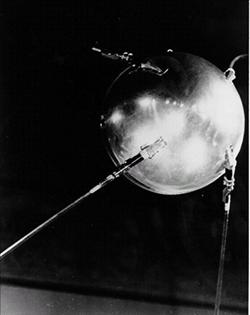 This month brings the 50th anniversary of two events that changed the world. The first, of course, needs little explanation: On October 4, 1957, the Space Age began with the Soviet Union's launch of the Sputnik 1 spacecraft. I want to talk about the event you probably aren't aware of.
This month brings the 50th anniversary of two events that changed the world. The first, of course, needs little explanation: On October 4, 1957, the Space Age began with the Soviet Union's launch of the Sputnik 1 spacecraft. I want to talk about the event you probably aren't aware of.
The October 1957 issue of Reviews of Modern Physics contains the article "Synthesis of the Elements in Stars" by Margaret Burbidge, Geoffrey Burbidge, William Fowler, and Fred Hoyle. The authors, known forever after by the initials BBFH, explained how stars cooked up elements heavier than hydrogen. Part of the process occurs in stellar cores during their long lives, the rest in violent supernova explosions that mark the end of massive stars' lives.
The alternative idea, proposed by Ralph Alpher and George Gamov in the 1940s, held that the elements arose in nuclear reactions at the birth of the universe. (See "How the Big Bang forged the first elements" in the October 2007 issue of Astronomy.) Yet Big Bang nucleosynthesis couldn't be the entire story. By the 1950s, astronomers were discovering radioactive elements with half-lives of millions of years in the spectra of stars. If all the elements formed shortly after the Big Bang, none would remain today. Stars had to be building at least some of these elements.
In more than 100 pages, the BBFH paper described in detail how the elements came to be. Interestingly, the whole concept owed at least a little bit to Fred Hoyle's use of anthropic reasoning — the idea that life's mere existence can be used to deduce truths about the cosmos.
One fundamental problem BBFH had to overcome was creating a carbon nucleus by fusing helium and beryllium nuclei. This could happen only if carbon had a special energy state, called a "resonance." Yet carbon had no known resonance. Hoyle reasoned that because life exists, and this life is based on carbon, then the resonance must also exist. He calculated how much energy the resonance must have, based on the temperature in stellar cores and the masses of both helium and beryllium. Willy Fowler led the Caltech team that ultimately discovered the carbon resonance — within a few percent of what Hoyle predicted.
In the end, science needed both BBFH's stellar nucleosynthesis and Big Bang nucleosynthesis to describe the cosmic abundance of elements. The Big Bang produces all the hydrogen, the lion's share of helium, and traces of lithium and beryllium. Stars and supernovae build the rest. It's an elegant theory — one that traces its roots back both to the beginning of time and to a paper published 50 years ago.